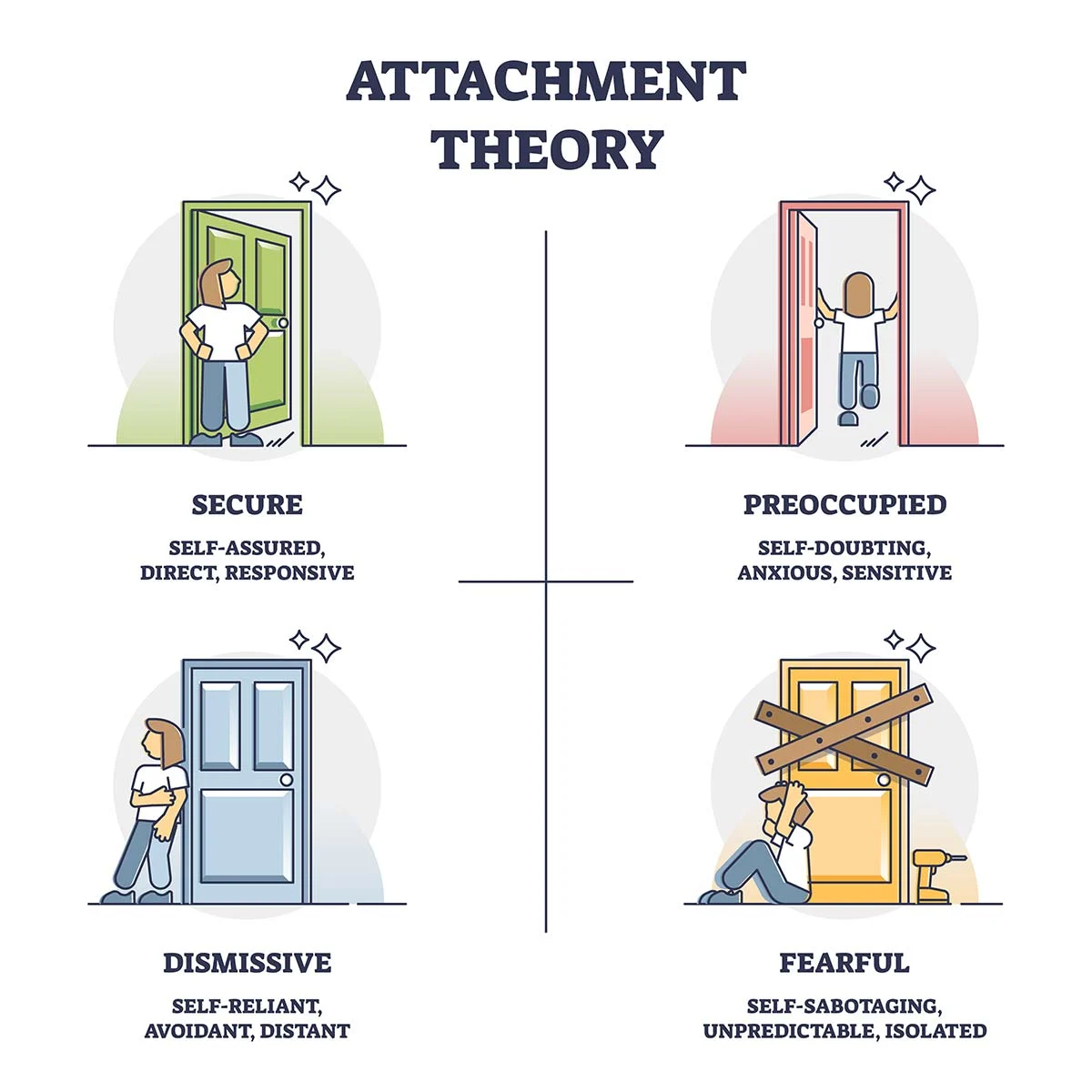As parents, our main goal is to raise happy, confident, and resilient children! There are many factors that contribute to raising our children, some that naturally occur within our DNA and others that make us a product of our environment.
One crucial aspect that greatly impacts a child’s emotional development is their attachment style. An attachment style is an emotional bond a child forms with their primary caregiver, typically a parent.
Understanding attachment styles can help us provide the love and support our kids need to become secure individuals.
In this blog, we’ll jump into the four main attachment styles: Secure, Avoidant-Dismissive, Avoidant-Fearful/Disorganized, and Anxious, and explore how we can raise secure kids.
What is an Attachment Style?

Attachment style is the way children perceive and respond to their caregivers’ availability and responsiveness. It is established during the early years and serves as a blueprint for their future relationships. The attachment style influences how children manage stress, regulate emotions, and interact with others throughout their lives.
The four types of attachment styles:
- Secure
- Avoidant
- Anxious (Ambivalent)
- Disorganized
Psychologists have been studying these relationships for over the past 50 years. These attachment style theories were founded by psychoanalyst John Bowlby in the 1950s and expanded by Mary Ainsworth.
“Bowlby believed that because of evolution, infants and toddlers were monitoring their parents to see what strategies would allow them to stay close,” explains Krista Jordan, Ph.D., a psychologist and couples therapist. This idea of proximity to our caregivers, when we are young and developing, was necessary for our survival (before modern times) and still has immense impacts today.
When a child can consistently rely on their guardians to be there for them, they are more likely to develop a secure attachment style. Avoidant, anxious, and disorganized are considered insecure attachment styles. These attachment styles develop if a child has a strained or unreliable relationship with their caregivers. This is later evident in our children’s lives as they form new friendships and start getting into relationships.
“The most important takeaway is realizing that someone can change from an insecure attachment style and develop healthy and secure bonds in future relationships,” explains Katarzyna Peoples, Ph.D., a relationship counselor and core faculty member at Walden University’s Counseling Education and Supervision doctoral program.
Breakdown of Attachment Styles in Children

Secure Attachment
Children with a secure attachment style feel safe and loved by their caregivers. They trust that their needs will be met, which allows them to explore the world with confidence.
Securely attached kids seek comfort from their parents when faced with challenges and know they can rely on them for support. As parents, we can foster secure attachment by being responsive, emotionally available, and consistently meeting our children’s needs.
These securely attached children tend to have a positive and healthy outlook on life. These positive outlooks encourage them to explore the world with curiosity and confidence.
Securely attached children are more likely to form strong, trusting relationships with others and develop essential social skills. They handle stress better and are more resilient when facing challenges.
Avoidant-Dismissive Attachment
Children with an avoidant-dismissive attachment style might appear independent and self-reliant. They may downplay their emotional needs and may not seek comfort or closeness when they are distressed.
This style often develops when caregivers consistently neglect emotional responsiveness. This may be intentional or unintentional by the caregiver. For example, some parents may simply have busy, demanding work schedules that could often lead to putting more emphasis on academics, chores, etc. While other parents are just downright neglectful, causing children to learn to fend for themselves at an early age.
These children can often end up struggling with emotional intimacy in the long run. They might avoid seeking comfort from caregivers during distress, which can lead to difficulties in expressing emotions and connecting with others – especially in adult relationships.
Avoidant attachment may hinder the development of empathy and emotional regulation. To raise secure kids with this attachment style, we should strive to validate their feelings and emotions, encouraging open communication. We should also find a balance between helping our children and letting our children have their independence.
It is one thing to raise self-sufficient children but is another thing to raise an avoidant-dismissive child.
Anxious Attachment
Anxiously attached children seek constant reassurance and attention from their caregivers. They may worry about being abandoned or rejected and display heightened emotional responses to separation.
This style may develop when caregivers are inconsistent in their responses or overly intrusive.
Children with an anxious attachment style often worry about being abandoned or rejected. They may be overly clingy and seek constant attention or mirroring from caregivers.
This attachment style can result in intense anxiety, codependency issues, and difficulty in coping with separation or new situations. Anxious children may find it challenging to develop a sense of independence and self-assurance.
To raise secure kids with an anxious attachment style, we should be responsive and empathetic while encouraging independence and self-soothing skills. Being consistent with comfort, reassurance, and positivity are so crucial to the development of our children, otherwise, an inconsistency can lead to these anxious feelings.
Avoidant-Fearful/Disorganized Attachment
Avoidant-fearful or disorganized attachment style is much different than the previous avoidant-dismissive attachment style. Children with disorganized attachment often display conflicting behaviors. These children may seem both clingy and avoidant, as they are unsure how to react to stress and fear.
This attachment style often emerges in response to inconsistent caregiving, such as parents who are sometimes nurturing and sometimes frightening. The most common causes of a disorganized attachment style are childhood trauma, neglect, or abuse.
Children with a disorganized attachment style may have high levels of anxiety, difficulty trusting others, and an over-hyped fear of rejection. Some children may show signs of both avoidant and anxious attachment styles. Disorganized attachment may lead to difficulties in managing emotions, forming stable relationships, and self-regulating.
To help our children develop a more secure attachment style, we need to provide them with a stable and predictable environment and reassure them of our love and protection. This is where the four S’s come into play.
The Four S’s: How Parents Can Foster Secure Attachment
Safe
“Safe” means assisting children in feeling and being safe. Children need to feel physically and emotionally safe in their interactions with their caregivers.
This means offering a sense of stability and predictability in their daily routines, ensuring that they can rely on you for protection and support. By responding sensitively to your child’s needs and fears, you instill in them the confidence to explore and engage with the world, knowing that they have a safe base to return to when needed.
Being “safe” also means having a commitment to your child after a dispute and even offering an apology where it is due. This seems simple enough but parents can often forget how important it is to stay accountable to our youngsters, not just other adults.
Seen
Children who feel “seen” also feel appreciated. As a caregiver, you can help your child feel seen by taking the time to comprehend what they are feeling or experiencing. This involves active listening, empathetic responses, and genuine interest in their thoughts and emotions.
Being fully present and attuned to your child’s needs helps them develop a positive self-image and self-worth. When you acknowledge and validate their feelings, you communicate that their experiences matter and that they are valued for who they are.
Soothed
Providing emotional soothing is a crucial aspect of secure attachment. “Soothed” children are comforted consistently and not only during emotional moments. When children experience distress or discomfort, responsive caregiving is key to helping them regulate their emotions effectively.
As a parent, comforting your child during moments of anxiety or fear reassures them that they are not alone in their emotions and that their feelings are valid. This helps build emotional resilience and the capacity to cope with challenges in the future.
Secure
The ultimate goal of the Four S’s is to instill a deep sense of security in your child. A secure attachment enables them to develop healthy relationships and face the world with confidence.
When children know they have a reliable and loving caregiver, they learn to trust and form secure connections with others. This sense of security becomes their inner anchor, empowering them to explore, learn, and thrive as they grow.
Raising secure children doesn’t have to be complicated. Giving our children the secure foundation they need physically and emotionally is the key to their ultimate success as resilient and capable adults.



